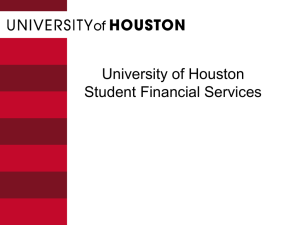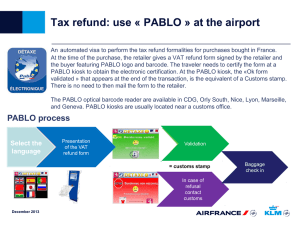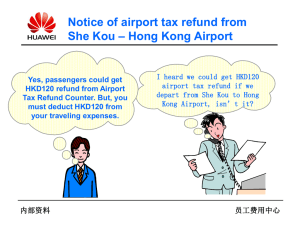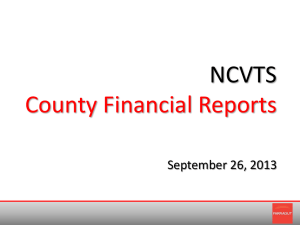Regulating the Tax Preparation Industry
advertisement
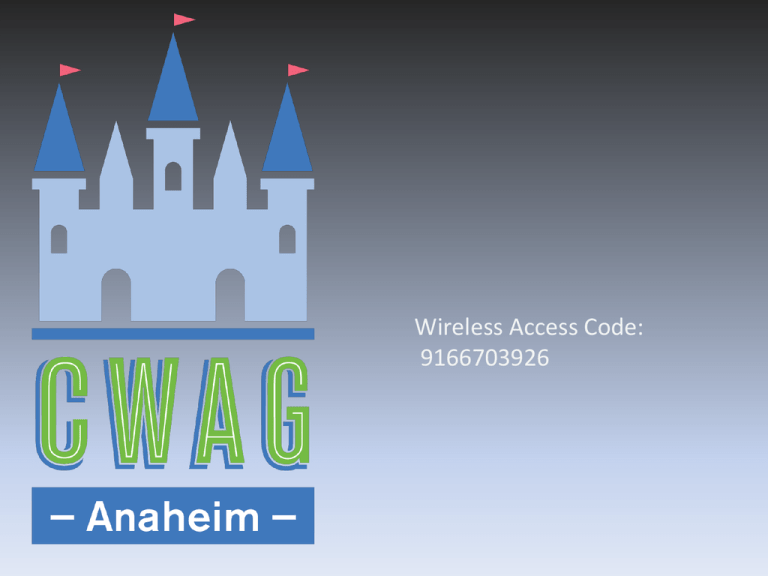
Wireless Access Code: 9166703926 Steve Trager President and Chief Executive Officer 2 Company Profile Second largest Kentucky based bank holding company with total assets of $3.4 billion at 3/31/11 Holding Company for Republic Bank & Trust Company (Kentucky) and Republic Bank (Florida) » 43 locations in KY, IN, OH, TN and FL Diverse Business Operating Segments » Traditional banking » Mortgage banking » Tax Refund Solutions (“TRS”) 3 What Are Refund Transfers (RTs)? In 2012, 108.8 million U.S. taxpayers received refunds. 19.79 million. RT: Refund Transfer. Also called: » RAC: Refund Anticipation Check » ERC: Electronic Refund Check The RT/RAC/ERC are generally the same type of product. None of these products are RALs (“Refund Anticipation Loans”) Popularity of RT product is growing: » 2012 -- 19.79 million taxpayers used RTs » 2011 -- 18.74 million taxpayers used RTs » 2010 -- 12.90 million taxpayers used RTs Growth of RTs is directly proportionate to the decline in RALs. 4 Major Reasons Why Taxpayers Use A Refund Transfer The RT with Efile provides faster refunds for unbanked customers: a bank account is established for the taxpayer and permits deposit of an IRS refund allowing them to receive the benefit of the speed of direct deposit in 7 – 13 days Without the RT and Efile, it takes the IRS 5-7 weeks to mail a paper check RT check customers can pick up their proceeds safely at the tax office, with no risk of loss or theft from their mailbox RT also gives taxpayers with no credit card or cash the option of paying for tax preparation fees from the refund But for the opportunity to utilize a professional tax preparer, many filers would not avail themselves of certain federal and state tax benefits (e.g., EITC) 5 Major Reasons Why Taxpayers Use A Refund Transfer RT unbanked customers likely can avoid a “check cashing” fee (1-3%), e.g., by disbursement on a debit card Low cost check cashing solutions are also arranged by financial providers of the product Some banked taxpayers don’t want the government to know their bank account number Some credit card holders still don’t want to use their card on the Internet 6 Best Practices For RT: What Can We Achieve Together? Best companies have the following practices » Transparently differentiate RT fees from fees for tax preparation » Additional methods for receipt of the refund and settlement options are presented (e.g., debit cards, direct deposit etc.) » Due diligence of tax offices when enrolled to ensure they meet established standards » Train tax preparers who offer the product » Oversee tax preparers with audit programs which include in office visits and/or mystery shops » Monitor offices for tax preparation fee abuses and fraud » Advertising approval process for tax office 7 Best Practices For RT: What Can We Prevent Together? Worst companies have bad practices » RT related fees are not differentiated from tax preparation fees or not adequately disclosed – hard to tell which fee is which » No due diligence process when an office is enrolled » Training is not provided to preparers » All refund and settlement options are not provided to consumers » No oversight of tax offices with audit programs » Tax preparation fees or fraud is not monitored » Tax office advertising materials are not reviewed 8 RT Is Not A “Finance Charge” Under TILA Office of Comptroller of the Currency guidance indicates RTs are not “loans” » Consumer groups have historically agreed with this distinction Customers do not pay the fee to tax preparer to obtain an “extension of credit.” Taxpayers pay participating banks to set up special bank accounts to receive the tax refund Unlike cases where courts have found costs to be hidden “finance charges,” the RT handling fee is plainly disclosed and not a “hidden” or “buried” charge 9 What Are The Differences Between An RT And A RAL? RAL is a loan. A portion of the refund is given in advance to the taxpayer within 24 hours from when the return is electronically filed. » Bank risk is that a refund is scheduled to be paid in an average of 12 days, but could be paid much later or not at all » With a RAL the, “bank” “loss” is the loan amount plus the fee if the refund is not received. » In contrast, with an RT, the “loss” for the “bank” is only the RT fee if the refund has not been received but the service to the consumer has not been provided RAL cost is approximately $61 for a $1,500 loan – an RT fee from the bank is approximately $30 An RT is not a loan: because nothing is provided by the bank in advance of the refund being received 10 Summary Customers want Refund Transfers The fee is reasonable Disclosures are effective-customers know exactly what they are getting and what they are paying Service is of value 11 Wireless Access Code: 9166703926
